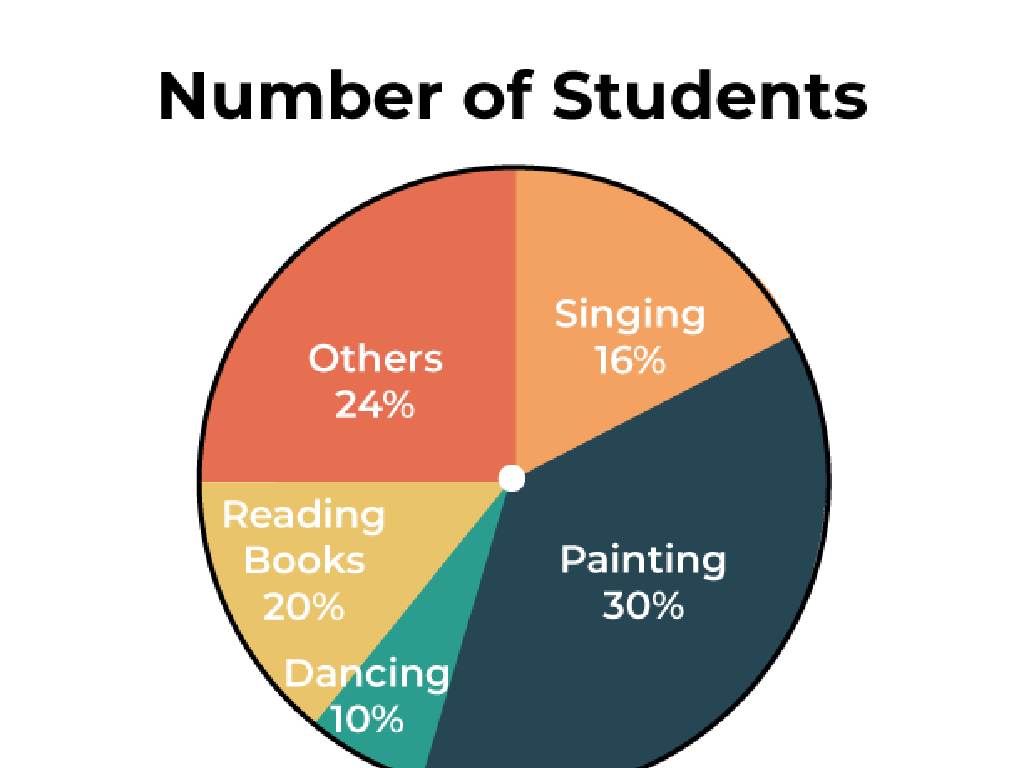Create And Interpret Line Plots With Fractions
Subject: Math
Grade: Fifth grade
Topic: Data And Graphs
Please LOG IN to download the presentation. Access is available to registered users only.
View More Content
Exploring Line Plots with Fractions
– Graphs translate data into visuals
– Visuals help us understand numbers better
– Overview of graph types
– Bar graphs, pie charts, histograms, etc.
– Focus on line plots with fractions
– Line plots show data along a number line
– Practice interpreting line plots
|
This slide introduces students to the concept of using graphs to understand data visually. Start by explaining how graphs can turn complex data into something we can see and easily understand. Provide a brief overview of different types of graphs such as bar graphs, pie charts, and histograms, and their uses. Then, shift the focus to line plots, specifically those that incorporate fractions, which are particularly useful for displaying data distributions. Emphasize that line plots with fractions help us see the frequency of data points. Conclude with an activity where students create and interpret their own line plots using fractional data to reinforce their understanding.
Understanding Line Plots
– What is a line plot?
– A graph that shows frequency of data on a number line
– ‘X’ marks on a number line
– Each ‘X’ above a number shows how often it appears
– Shows data frequency
– Easily see which items or amounts are most common
– Ideal for comparing fractions
|
A line plot is a simple yet powerful tool for displaying data, especially useful for visualizing the distribution and frequency of data points. When teaching fifth graders, emphasize that each ‘X’ on the plot represents an occurrence of a data point. This visual representation helps students quickly identify which data points appear most frequently. Line plots are particularly effective for comparing fractional data because they allow students to see the fractions along a number line, making it easier to understand the size of fractions relative to each other. Encourage students to create their own line plots using data from class surveys or measurements taken during experiments.
Understanding Fractions
– What exactly is a fraction?
– A fraction represents a part of a whole.
– Numerator vs. Denominator
– Top number (numerator) and bottom number (denominator).
– Fractions in daily life
– Pizza slices, measuring cups, and money (quarters).
– Visualizing fractions
– Use objects or drawings to see fractions.
|
Begin the lesson with a review of fractions to ensure a solid foundation for creating and interpreting line plots with fractions. Explain that a fraction represents a part of a whole, like a slice of pizza. Clarify the roles of the numerator and denominator, with the numerator indicating how many parts we have and the denominator showing the total number of equal parts in the whole. Provide relatable examples such as slices of pizza for 1/2 or 1/4, measuring cups in cooking for 1/3 or 3/4, and money, like quarters representing 1/4 of a dollar. Encourage students to visualize fractions by dividing shapes or using objects to represent different fractions. This will help them better understand and interpret data on line plots involving fractions.
The Role of Fractions in Line Plots
– Fractions show in-between values
– They represent values like 1/2 or 3/4, not just whole numbers.
– Enable precise measurements
– Fractions allow us to measure with greater detail than whole numbers.
– Reflect real-world data accurately
– Data like height, weight, or time often includes fractions.
– Essential for detailed analysis
|
This slide explains why fractions are important when creating line plots. Fractions allow students to represent and understand values that fall between whole numbers, which is crucial for precision in measurements. Many real-world scenarios involve fractional values, such as cooking recipes or measuring height, making it essential for students to know how to include and interpret fractions in data representation. Encourage students to think of examples where they encounter fractions in their daily lives. This understanding lays the groundwork for more complex data analysis and helps students appreciate the relevance of math in the real world.
Creating a Line Plot with Fractions
– Draw a horizontal number line
– Mark line with fraction increments
– Space out fractions evenly on the line
– Plot data points with Xs
– Each X represents a data point above its fraction
– Interpret the plotted data
– Analyze the frequency of data points
|
This slide introduces the steps to create a line plot with fractions, which is a visual representation of data distribution over a number line. Start by drawing a horizontal line, which will serve as the base for the plot. Next, mark the number line with evenly spaced fractions that are relevant to the data set. Then, students will plot the data by placing Xs above the corresponding fractions on the number line, stacking them if frequencies repeat. Finally, students will learn to interpret the line plot by analyzing the frequency of the data points represented by the Xs. This activity helps students understand data distribution and practice their skills with fractions.
Interpreting Line Plots with Fractions
– Reading a line plot correctly
– Observe the title, scale, and what each ‘X’ represents
– Count Xs for frequency of data
– Each ‘X’ above a number shows how often that data appears
– Compare different data points
– Look at the ‘Xs’ to see which data is most or least common
– Understanding fractions on plots
– Fractions show parts of a whole on the plot
|
This slide aims to teach students how to interpret line plots that include fractional data. Start by explaining the components of a line plot, including the title, which tells us what the data is about, and the scale, which shows the range of data. Emphasize that each ‘X’ represents a count of how often a data point occurs. Students should practice counting the ‘Xs’ to determine the frequency of data points. Encourage them to compare different data points to understand which are more or less common. Lastly, ensure they grasp how fractions are depicted on the plot, representing parts of a whole. Use examples with common fractions they are familiar with, such as 1/2 or 1/4, to solidify their understanding.
Class Activity: Shoe Size Line Plot
– Collect classmates’ shoe sizes
– Create a line plot with sizes
– Mark fractions on a number line to represent each shoe size
– Interpret data from the plot
– What does the plot tell us about most common sizes?
– Discuss findings as a class
– Share observations about the range and distribution
|
This class activity is designed to help students understand how to collect data and represent it using a line plot, specifically focusing on fractions. Start by having each student measure their shoe size. Then, guide the class in plotting these sizes on a line plot, ensuring that they understand how to represent each size as a fraction on the plot. Once the plot is created, lead a discussion on what the plot reveals, such as the most common shoe size, the range of sizes, and any patterns observed. This activity will not only reinforce the concept of line plots but also provide a practical application of fractions. Possible variations of the activity could include grouping sizes by gender, comparing with another class, or predicting sizes for next year.
Practice Time: Creating Line Plots
– Let’s create a line plot together
– Use daily life data for practice
– Think about things you measure every day, like time spent on homework.
– Work in pairs for data collection
– Partner up and decide what to measure, then gather your data.
– Plot the data on your line plot
– Use the data to draw dots above the number line for each fraction you find.
|
This slide is designed to engage students in a hands-on activity where they will apply their knowledge of line plots and fractions. Encourage them to think of daily activities that involve measurement, such as time spent reading or the amount of water they drink, and use those measurements to create a line plot. Working in pairs will allow them to collaborate and discuss their findings. Provide them with graph paper and have them plot their data points above a number line that includes fractions. This will help them visualize the distribution of data and interpret the line plot they create. Offer guidance on how to represent fractions on the plot and ensure they understand how to read the plot once it’s complete. Prepare to walk around the classroom to assist pairs as needed and to facilitate discussion about their findings.
Class Activity: Our Favorite Fruits
– Pick your favorite fruit
– Measure and record its weight as a fraction
– Use scales to find the weight; write it like 1/2 lb, 3/4 lb
– Plot the weights on a line plot
– Draw a number line and mark the fractions
– Analyze the line plot as a class
– What can we learn about our fruit choices and their weights?
|
This activity is designed to provide hands-on experience with measuring and recording data using fractions, and then representing that data on a line plot. Students will first select a fruit and use a scale to determine its weight, recording this as a fraction (e.g., 1/2 pound). Next, they will create a line plot on a number line, marking the weights of the fruits accordingly. This visual representation will help them to interpret the data collectively. As a teacher, prepare to guide them through measuring, recording, and plotting. Have additional activities ready for fast finishers, such as comparing the most common fruit weights or adding more data points to the plot.
Conclusion & Homework: Line Plots with Fractions
– Review line plots with fractions
– Recall how to plot data points that are fractions on a line plot.
– Real-life applications
– Discuss how line plots help in everyday situations, like measuring ingredients for a recipe.
– Homework: Create your line plot
– Find something to measure at home, like the amount of water each plant gets, and plot it.
|
As we wrap up, let’s revisit the concept of line plots with fractions, emphasizing their importance in representing and interpreting data. Encourage students to think about how these plots are used in daily life, such as in cooking or tracking sports statistics. For homework, students should find a relatable example at home where they can collect fractional data and create their own line plot. This could involve measuring liquids, lengths, or quantities. Remind them to label their plot clearly and to be prepared to explain their findings in the next class. This exercise will reinforce their understanding and show them the practical use of line plots with fractions.






